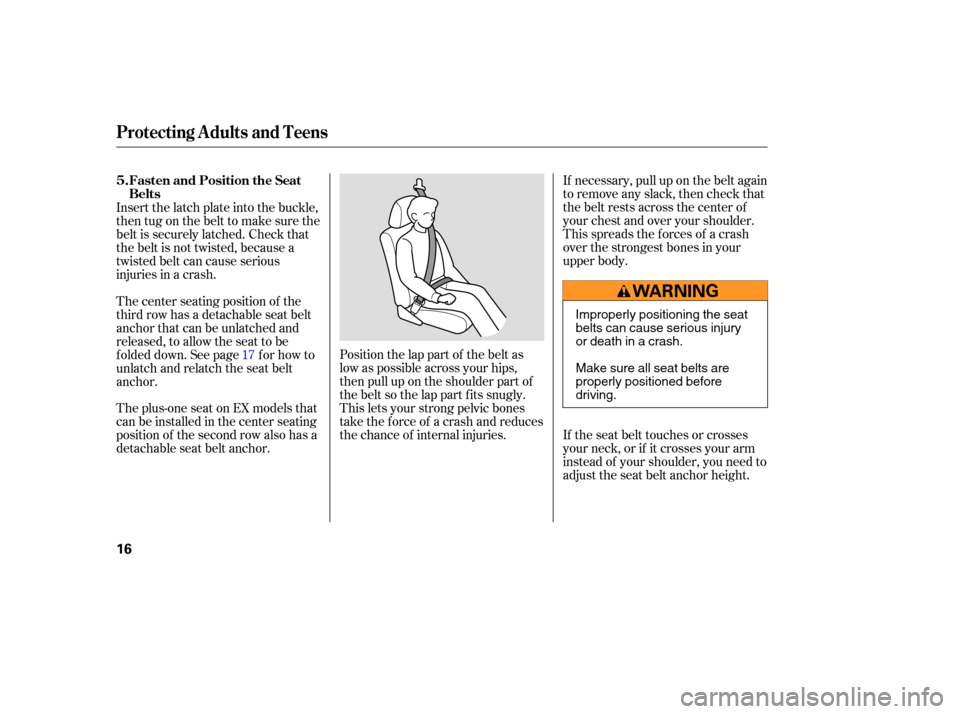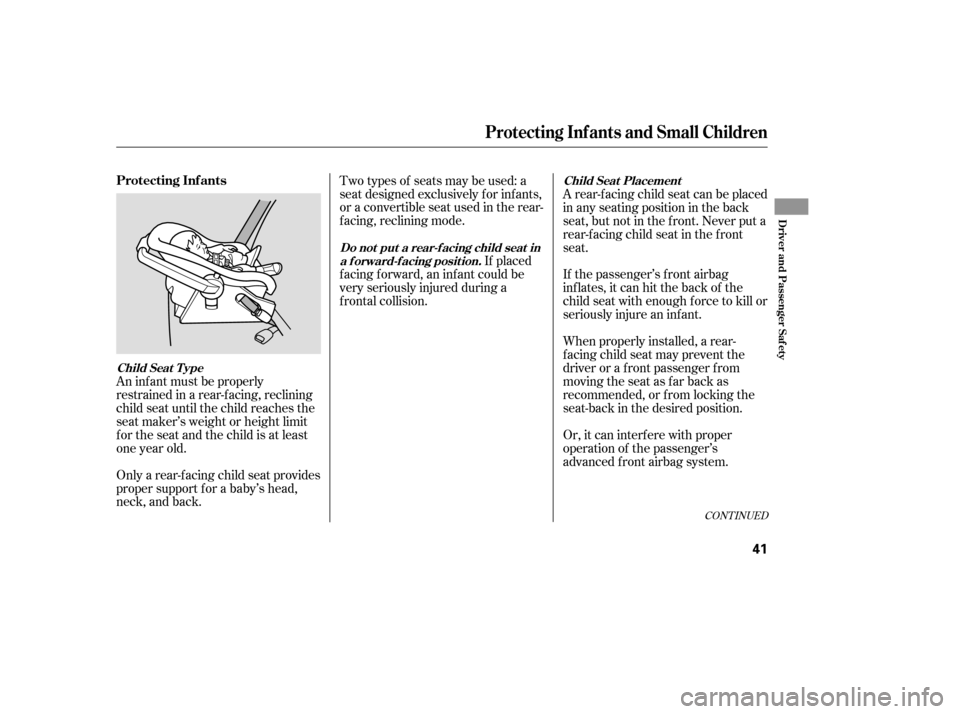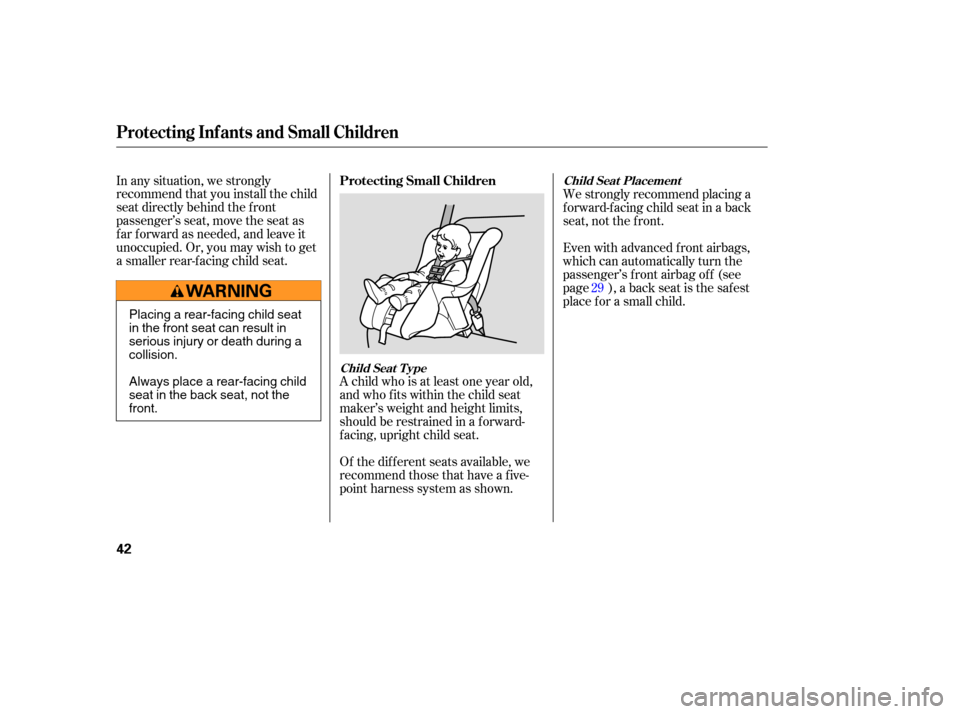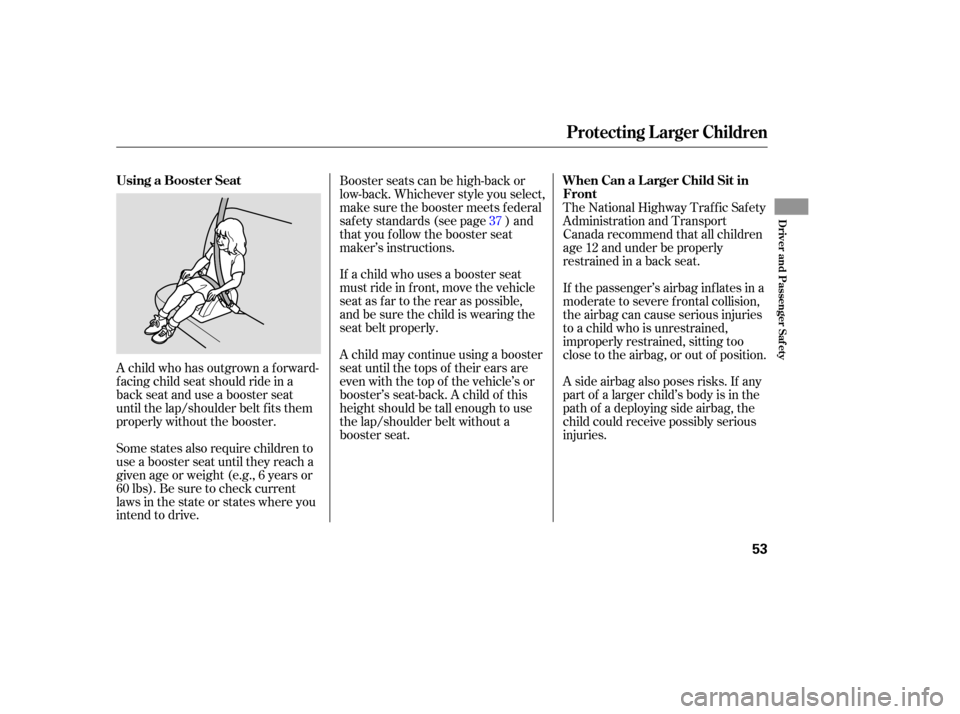Page 17 of 414

If necessary, pull up on the belt again
to remove any slack, then check that
the belt rests across the center of
your chest and over your shoulder.
This spreads the f orces of a crash
over the strongest bones in your
upper body.
If the seat belt touches or crosses
your neck, or if it crosses your arm
instead of your shoulder, you need to
adjust the seat belt anchor height.
Position the lap part of the belt as
low as possible across your hips,
then pull up on the shoulder part of
the belt so the lap part f its snugly.
This lets your strong pelvic bones
take the force of a crash and reduces
the chance of internal injuries.
Insert the latch plate into the buckle,
then tug on the belt to make sure the
belt is securely latched. Check that
the belt is not twisted, because a
twisted belt can cause serious
injuries in a crash.
The center seating position of the
third row has a detachable seat belt
anchor that can be unlatched and
released, to allow the seat to be
f olded down. See page f or how to
unlatch and relatch the seat belt
anchor.
The plus-one seat on EX models that
canbeinstalledinthecenterseating
position of the second row also has a
detachable seat belt anchor.
17
Protecting A dults and Teens
Fasten and Position the Seat
Belts
5.
16
Improperly positioning the seat
belts can cause serious injury
or death in a crash.
Make sure all seat belts are
properly positioned before
driving.
Page 18 of 414
CONT INUED
The f ront seats and second row seats
have adjustable seat belt anchors. To
adjust the height of an anchor,
squeeze the two release buttons, and
slide the anchor up or down as
needed (the anchor has f our
positions).Pull out the anchor latch and the
latch plate f rom each holding slot in
the ceiling, and pull out the seat belt
to extend it.Insert the hook at the end of the
anchor latch into the anchor buckle
by lining up the triangle marks on
the anchor latch and buckle. Make
sure the belt is not twisted. Push the
anchor latch until it locks. Then
f ollow the procedure f or f astening an
ordinary seat belt (see page ).
16
The plus-one seat on EX model also has
this type of seat belt.
Protecting A dults and Teens
Using t he L ap/Shoulder Belt in t heCent er Posit ion of t he T hird Row
Driver and Passenger Saf ety
17
RELEASE
BUTTONS LATCH
PLATE
ANCHOR
LATCHANCHOR
LATCH
ANCHOR
BUCKLE
Page 42 of 414

An inf ant must be properly
restrained in a rear-f acing, reclining
child seat until the child reaches the
seat maker’s weight or height limit
for the seat and the child is at least
one year old.
Only a rear-f acing child seat provides
proper support f or a baby’s head,
neck, and back.Two types of seats may be used: a
seat designed exclusively f or inf ants,
or a convertible seat used in the rear-
f acing, reclining mode.
If placed
f acing f orward, an inf ant could be
very seriously injured during a
f rontal collision. If the passenger’s f ront airbag
inflates, it can hit the back of the
child seat with enough f orce to kill or
seriously injure an inf ant.
When properly installed, a rear-
f acing child seat may prevent the
driver or a f ront passenger f rom
moving the seat as far back as
recommended, or f rom locking the
seat-back in the desired position.
Or, it can interf ere with proper
operation of the passenger’s
advanced front airbag system. A rear-f acing child seat can be placed
in any seating position in the back
seat, but not in the f ront. Never put a
rear-f acing child seat in the f ront
seat.
CONT INUED
Protecting Inf ants
Child Seat T ype Child Seat Placement
Do not put a rear-f acing child seat in a f orward-f acing position.
Protecting Inf ants and Small Children
Driver and Passenger Saf ety
41
Page 43 of 414

Of the different seats available, we
recommend those that have a f ive-
point harness system as shown.
In any situation, we strongly
recommend that you install the child
seat directly behind the f ront
passenger’s seat, move the seat as
f ar f orward as needed, and leave it
unoccupied. Or, you may wish to get
a smaller rear-f acing child seat.
A child who is at least one year old,
and who fits within the child seat
maker’s weight and height limits,
should be restrained in a f orward-
f acing, upright child seat.We strongly recommend placing a
forward-facing child seat in a back
seat, not the f ront.
Even with advanced front airbags,
which can automatically turn the
passenger’s f ront airbag of f (see
page ), a back seat is the saf est
place f or a small child.
29
Protecting Small Children
Child Seat T ype Child Seat Placement
Protecting Inf ants and Small Children
42
Placing a rear-facing child seat
in the front seat can result in
serious injury or death during a
collision.
Always place a rear-facing child
seat in the back seat, not the
front.
Page 52 of 414
Attach the tether strap hook to the
anchor, making sure the strap is
not twisted.
Tighten the strap according to the
seat maker’s instructions.The center seating position of the
third row has an anchorage point on
the tailgate sill.
Remove the bead restraint, then
route the tether strap over the
seat-back.
Slide the anchor cover to open it. When a child reaches the
recommended weight or height limit
for a forward-facing child seat, the
child should sit in a back seat on a
booster seat and wear a lap/shoulder
belt.
The f ollowing pages give
instructions on how to check proper
seat belt f it, what kind of booster
seat to use if one is needed, and
important precautions f or a child
who must sit in f ront.
Follow step 2 and 3 of the second
row installation.
2.
1.
3.
2.
3.
CONT INUED
T hird Row Inst allat ionProtecting L arger Children
Installing a Child Seat, Protecting L arger Children
Driver and Passenger Saf ety
51
ANCHORAGE POINT
Page 54 of 414

A child who has outgrown a forward-
f acing child seat should ride in a
back seat and use a booster seat
until the lap/shoulder belt f its them
properly without the booster.
Some states also require children to
use a booster seat until they reach a
given age or weight (e.g., 6 years or
60lbs).Besuretocheckcurrent
laws in the state or states where you
intend to drive.If a child who uses a booster seat
must ride in f ront, move the vehicle
seat as far to the rear as possible,
and be sure the child is wearing the
seat belt properly.
A child may continue using a booster
seat until the tops of their ears are
even with the top of the vehicle’s or
booster’s seat-back. A child of this
height should be tall enough to use
the lap/shoulder belt without a
booster seat. Booster seats can be high-back or
low-back. Whichever style you select,
make sure the booster meets f ederal
saf ety standards (see page ) and
that you f ollow the booster seat
maker’s instructions.
The National Highway Traffic Safety
Administration and Transport
Canada recommend that all children
age 12 and under be properly
restrained in a back seat.
If the passenger’s airbag inf lates in a
moderate to severe frontal collision,
the airbag can cause serious injuries
to a child who is unrestrained,
improperly restrained, sitting too
close to the airbag, or out of position.
A side airbag also poses risks. If any
part of a larger child’s body is in the
path of a deploying side airbag, the
child could receive possibly serious
injuries.
37
Protecting L arger Children
Using a Booster Seat
When Can a L arger Child Sit in
Front
Driver and Passenger Saf ety
53
Page 151 of 414
To change the seat-back angle of the
bucket seats in the second row, pull
forwardontheleverontheoutside
of the seat-back. To change the seat-back angle of the
f ront seat, pull up on the lever on the
outside of the seat bottom.The lef t and right halves of the third
seat-back can be adjusted separately.
To adjust the angle, pull the
adjustment strap on the outside of
each seat-back, move the seat-back
to the desired position, and release
the adjustment strap. Let the seat-
back latch in the new position.The height of your driver’s seat is
adjustable. Pull up the lever on the
outside of the seat cushion to raise
the seat bottom or push the lever
down to lower the seat cushion.
Make all adjustments bef ore you
start driving.
On LX model
Driver’s Seat Manual Height
Adjustment
Seats
150
ADJUSTMENT STRAP
Page 154 of 414
To get into or out of the third row
seat, walk between the second row
seats.When the seat on the passenger’s
side is moved to the center, walk
through the passenger’s side to get
into or out of the third row seat.
All head restraints adjust f or height.
You need both hands to adjust the
restraint. Do not attempt to adjust it
while driving. To raise it, pull upward.
To lower the restraint, push the
release button sideways, and push
the restraint down.
On the Touring model, you need to
remove the second row console
before you can make this seat
adjustment.
CONT INUED
T hird Seat A ccess
Seats
Inst rument s and Cont rols
153
RELEASE
BUTTON